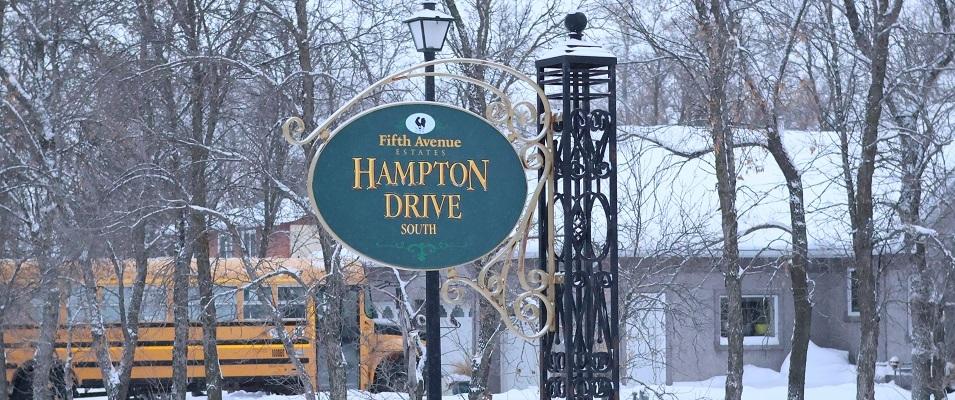Niverville’s town council is planning to roll out a pair of new safety measures in the coming year, in the form of new crosswalks and surveillance cameras.
Crosswalks
Council hopes to complete installation of two new crosswalks along the busy Fifth Avenue South early in 2023, which will provide a higher level of safety for this stretch of road which is seeing ever-increasing pedestrian traffic.
The two areas in question include the intersections of Hampton Drive North in the vicinity of Niverville Middle School, as well as Hampton Drive South where it crosses Fifth Avenue to enter Hespeler Park.
Since Fifth Avenue falls under the province’s jurisdiction, an application has to be submitted to Manitoba Transportation and Infrastructure (MTI) before any changes can be made along the route.
“We’ve heard from residents and have had our engineers and staff look at [these intersections],” says Mayor Myron Dyck. “We see that there is a lot of traffic of pedestrians—children, young people, all ages—trying to get into the park and also trying to get across to be able to get to various schools.”
The Hampton Drive South intersection saw at least one mishap last summer when a 14-year-old child on a bicycle collided with a passing pickup truck that was hidden from view by another vehicle.
Emergency crews were called in, and luckily the child sustained only minor scrapes. But the accident served to raise some legitimate concerns over safety at this corner.
Submitting an application to MTI for crosswalks will set a process in motion, says CAO Eric King. MTI responds by sending out an inspector to perform pedestrian traffic counts at both intersections. This will help determine the province’s level of participation and the degree of safety equipment that they’ll provide.
“If they say that it doesn’t meet all of their metrics, we probably have the money set aside in the budget for this year to do it ourselves, as long as they authorize us to do it,” says King.
King adds that there may also be an option of shared funding between the town and MTI. If, for example, MTI is willing to install the paint and signage, council may choose to go one step further by adding safety lights at one or both crosswalks.
The crosswalk safety lights currently in use at the intersection of Mulberry Avenue and Main Street will be coming down once traffic lights go up in 2023. At this point, King says that council will consider moving them to one of the two locations on Fifth Avenue South.
Lindsay Salonius is the mother to the child whose bicycle collided with a pickup truck this past summer. She says it’s a terrifying feeling to receive a phone call telling you that your child has been involved in a vehicular accident.
“This area is high-traffic for kids and sometimes they don’t think things through,” Salonius says. “So providing a crosswalk will help keep them safe. In addition, it will allow for vehicles to be more aware of this area so they are alert. Changes need to be made so no other mother gets that call, or worse information.”
She says that she’s thankful for Councillor Bill Fast, who heard her concerns and has set this ball into motion.
Surveillance Cameras
Also in keeping with community safety, council plans to add six new surveillance cameras to the approximate 20 that already exist around the town’s outdoor public spaces.
As well, they’ll be looking to install an audio system at the town office to augment the surveillance system. Extra town personnel will be added to the list of those authorized to view video surveillance footage and provide information to the RCMP.
The new cameras will likely be destined for some of the smaller parks scattered throughout the town. Existing cameras are in place along Main Street, in Hespeler Park, at the CRRC, and in some commercial zones.
The surveillance camera initiative first began a number of years ago on Councillor Chris Wiebe’s recommendation when small-scale local crime was seeming to become a regular occurrence.
But council’s plan was to create more than just a deterrent. Guided by RCMP consultations, council determined that an investment in high-definition cameras would serve a greater purpose.
“The RCMP gave us their pixel standards and said that if you’re going to use this in court, you have to have [a minimum quality] or it’s basically just a box,” says Mayor Dyck. “So we chose to go with [their recommendation].”
Since that time, Wiebe says that they’ve been able to provide police with video footage showing youth stealing signs and details of car accidents, as well as tracking a vehicle used by thieves to commit robbery.
On one occasion, they even caught on tape a pedestrian as they were hit by a car.
In many circumstances, council says that the footage has been invaluable to the RCMP to determine fault or locate perpetrators. Other times, the footage serves to help the police build a file on suspects.
Even petty crime has been curbed thanks to video surveillance, says King. He gives the example of a group of local children who were caught on camera painting graffiti on a publicly owned building. Thanks to video footage of the act, the RCMP were able to identify the children and pay a house call. What resulted was community service hours spent by removing the graffiti.
“I think it’s probably safe to say we won’t have a problem with those kids anymore,” muses King.
Each camera comes at an average cost to the town of $2,500. Initially council proposed a buy-in for local businesses, seeing the cameras as a benefit to the business community. Unfortunately, King says most respondents found the price prohibitive and have installed their own surveillance devices.
Even so, council is confident that the benefit to the community has been measurable enough to account for the additional public expense.


